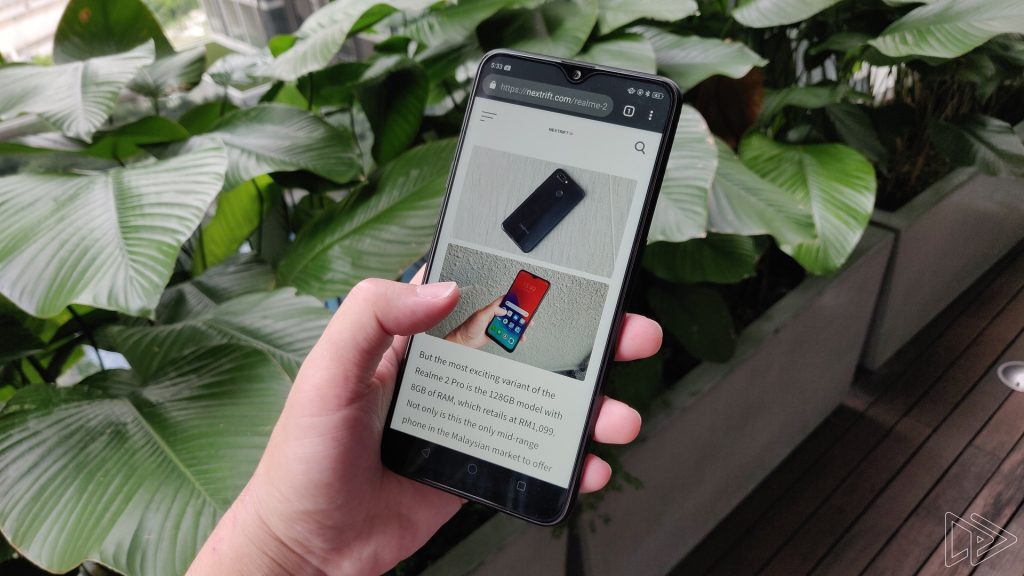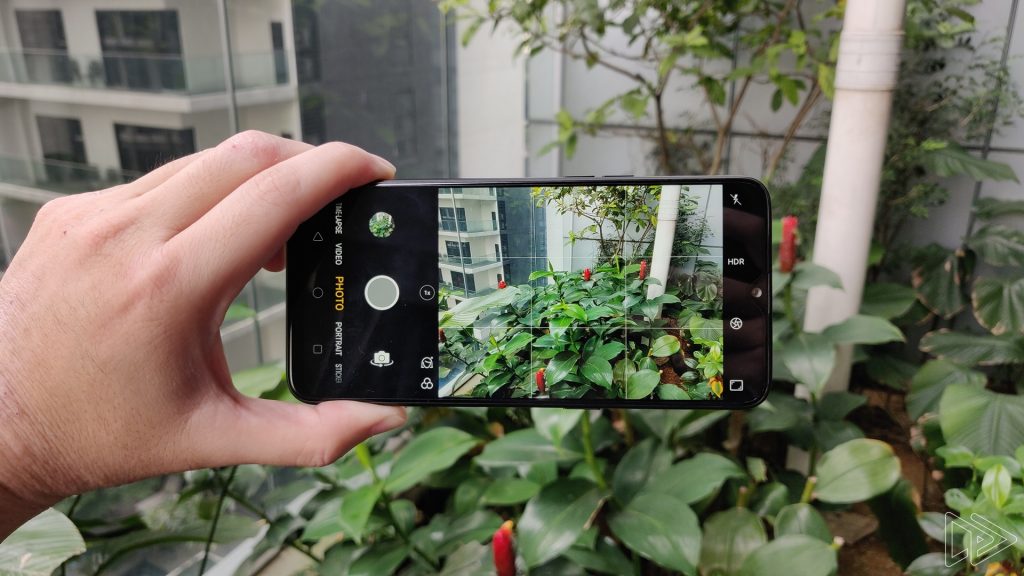It hasn’t even been a year since Realme officially entered the smartphone market. And yet, this sub-brand of Oppo has released quite a number of interesting smartphones. Arguably the most interesting of the bunch now is this phone right here: the Realme 2 Pro.
With a competitive price tag, capable hardware, and no glaring faults, the Realme 2 Pro is a compelling mid-range smartphone. It does have its fair share of downsides, but if you’re in the market for a new, affordable smartphone, this device should be in your list of consideration.
Specifications
| Display | 6.3-inch FHD+ IPS LCD (2340 x 1080) |
| Chipset | Qualcomm Snapdragon 660 1.95GHz octa-core |
| GPU | Adreno 512 |
| RAM | 4/6/8GB |
| Storage | 64/128GB, expandable |
| Camera (rear) | 16MP f/1.7 + 2MP f/2.4 |
| Camera (front) | 16MP f/2.0 |
| Battery | 3,500mAh |
| Dimensions | 156.7 x 74 x 8.5 mm |
| Weight | 174g |
| OS | ColorOS 5.2 based on Android 8.1 Oreo |
| Connectivity | LTE Bluetooth 5.0 WiFi 802.11 a/b/g/n/ac microUSB |
For a mid-range smartphone, the Realme 2 Pro is pretty well-equipped. It runs on a fast Qualcomm Snapdragon 660 chipset, up to 8GB of RAM, and 128GB of internal storage. It also has a reasonably sized 3,500mAh cell, which should return decent battery life.
Design
Functional is how’d I describe the Realme 2 Pro’s design language, and that’s a good thing. There’s no design element that’s unnecessary, and it has the essentials covered. These include support for expandable storage, ergonomically-sound design, and even a 3.5mm headphone jack.
If there’s anything I don’t quite like about this phone, it’s the fact that it doesn’t use USB-C. Then again, this is an affordable smartphone. Most devices in this price range still use microUSB ports anyway.
Despite the polycarbonate construction of the Realme 2 Pro – the back panel and matte frame of the phone are plastic – it feels solid in my hands. It doesn’t feel premium by any means, of course, but it definitely has solid build quality. I also like the Realme 2 Pro’s 8.5mm thick chassis, which makes it easy to get a good grip on the phone.
On the front, you won’t miss the Realme 2 Pro’s “Dewdrop” notch. While it’s a minimal notch, it does get in the way when I’m on certain apps. This can get quite annoying, but there is an option in the settings that forces selected apps to not use the notched area. This way, you can avoid the issue you see in the image above.
Notch aside, I do like the small bottom bezel of the Realme 2 Pro. It gives the phone an almost bezel-less aesthetic, and in this price range, it’s a standout design for the phone.
Overall, the Realme 2 Pro has a functional, minimalist design. It doesn’t have any fancy design elements like a gradient finish or glass back, but adding these will only drive up the price of the Realme 2 Pro. After all, this phone’s competitive pricing is one of its most appealing qualities.
User Experience
Let’s start with software. Running on ColorOS 5.2 based on Android 8.1 Oreo, the Realme 2 Pro…has decent software experience. It runs fine for the most part, and even though I miss the presence of an app drawer, ColorOS feels responsive and lightweight.
However, there is one fundamental flaw with ColorOS 5.2: you cannot swipe away notifications. This is a staple feature of the Android operating system, and it’s really mind-boggling that ColorOS doesn’t allow notifications to be swiped away. Instead, you’d have to swipe notifications to the left to reveal the option to remove them. This proved to be a really, really frustrating experience when I have more than a couple of notifications to remove.
Thankfully, a recent update fixed this. Now, you can swipe away notifications, but only with a right swipe. A left swipe will still reveal the options; this is very similar to how Xiaomi’s MIUI software handles notifications.
But hey, at least you can swipe away notifications now on ColorOS, even though it’s only with a right swipe.
On a more positive note, I really like the Realme 2 Pro’s 6.3-inch 1080p display. It’s a bright display with punchy colours, good viewing angles, and overall, it looks like a high quality screen. It’s no OLED display, of course, but at this price point, it’s definitely an above average IPS panel.
Performance is also another strong point of the Realme 2 Pro, especially at this price point. Powered by Qualcomm’s Snapdragon 660 chipset, gaming on this phone is enjoyable – especially Ragnarok M – and throughout my time with the phone, I didn’t notice any performance issue either.
But when it comes to battery life, the Realme 2 Pro…is difficult to measure. The thing is, I don’t know how long it can last on a single charge. Unlike other versions of Android, ColorOS doesn’t let me check the screen on time of the phone. That makes it pretty hard to get a grasp on the Realme 2 Pro’s battery life.
That being said, the phone can last me through a typical workday on a single charge quite comfortably. At the end of the day, I’m usually left with about 20% battery life. I’m a heavy smartphone user, and I’m constantly connected to my phone, so this is quite decent.
What about the Realme 2 Pro’s charging rate? Well, it’s okay. Plugging in the phone for 30 minutes charged it up to 30% from empty.
I’m not a huge fan of ColorOS on the Realme 2 Pro, but I do like the fact that it feels fast and responsive throughout my time with the phone. I’m also really happy the notification system has been fixed in a recent update, although it’s still limited to removing notifications with only a right swipe.
In spite of that, I really enjoyed using the Realme 2 Pro as my daily driver. Now, let’s get to its camera performance – a common weak point for affordable smartphones.
Camera
Featuring a 16MP + 2MP dual camera system, the Realme 2 Pro is a decent shooter. In daytime, it can take good-looking shots, but this is a given with the majority of smartphones released in recent times. Come nighttime, however, the camera performance takes a dive.
In less than ideal lighting, the Realme 2 Pro’s camera app gets more sluggish, and the image output leaves much, much to be desired. Noise is apparent in challenging lighting conditions, details are lacking, and on top of that, the absence of optical image stabilisation makes it difficult to capture clear, sharp images.
Of course, it’s still very possible to capture good low light shots with the Realme 2 Pro, but you have to really work for it. With enough patience and composition, it will do in a pinch when shooting under challenging lighting situations.
But, again, you’ll have to be really, really patient.
What about the 16MP front-facing camera? It’s pretty decent. After all, Realme is a sub-brand of Oppo – the company knows a thing or two about selfie cameras. Occasionally, selfies do come out looking soft, but as a whole, it’s definitely above average for a device in this price point.
Competition
Here’s where it gets really interesting. The Realme 2 Pro is priced from only RM849, and that’s for the 64GB model with 4GB of RAM; very reasonable. A tier up is the RM949 variant, which offers 64GB of storage with 6GB of RAM. The highest-end model, on the other hand, comes with 128GB of storage and a whopping 8GB RAM for RM1,049.
Without a doubt Realme is pricing this phone aggressively, and do note that the Realme 2 Pro is often discounted even further on certain e-commerce platforms like Shopee. Regardless, there are a couple of noteworthy alternatives to this phone.
Xiaomi Mi A2
We can’t talk about smartphones with good value for money without Xiaomi, and the Mi A2 is a direct competitor to the Realme 2 Pro. Not only does the Mi A2 run on the same Snapdragon 660 chipset, it also has superior camera performance, an all-metal chassis, and thanks to its status as an Android One device, it has far better software experience and update timing.
On top of that, the Mi A2 is priced very closely to the Realme 2 Pro as well. Not too long ago, Xiaomi revised the Mi A2’s pricing to RM899 and RM1,099 for the 64GB + 4GB and 128GB + 6GB models respectively. Considering the upgrades you’re getting with the Mi A2, why would you get the Realme instead?
Well, for a number of reasons. For one, the Realme 2 Pro supports expandable storage, not to mention a larger 3,500mAh battery and more RAM at 8GB for the 128GB variant. Although it doesn’t have the Mi A2’s USB-C port – it has a microUSB connection instead – the fact that the Realme 2 Pro retains the 3.5mm headphone jack somewhat makes up for this.
Huawei Nova 3i
The Huawei Nova 3i is also a pretty compelling choice over the Realme 2 Pro. Although it features a Huawei Kirin 710 chipset instead of the Realme’s Snapdragon 660 SoC, you should get comparable performance level with these two chipsets. Aside from that, you’re also getting a much sleeker-looking device with Huawei’s offering, thanks to its unique gradient colourway.
But the Nova 3i does lose out ever so slightly when it comes to value for money. Retailing at RM1,099, the Nova 3i comes with 128GB of storage and only 4GB of RAM; that’s half the amount of RAM the Realme 2 Pro offers with the RM1,049 model.
Then again, I’d argue you don’t need that much RAM anyway on the Realme. But hey, why settle for less when you can get more? You’re also saving a bit more money with the Realme 2 Pro.
Conclusion
The Realme 2 Pro is a very good mid-range smartphone. It has a minimalist, no-nonsense design, it has ample amount of RAM and storage (with a good level of performance), and most importantly, it doesn’t cost a fortune.
But you will have to contend with the oddities of ColorOS, not to mention mediocre camera performance and average battery life. If you can live with the Realme 2 Pro’s drawbacks, you will be very happy with this mid-range phone.
Especially with its excellent value for money.





























One Reply to Realme 2 Pro Review: Real Value for Money
Very impressive specs and price. In below RM1k (just -RM1 in Shopee) you can get a device with UFS 2.1 blazing storage technology combined with massive memory capacity — 128/8 GB. Really don’t know the hype of having a hugeass RAM in smartphone while only using it for casual stuff. The downside is only the micro-USB connector, when others are start using USB-C for future proofing and fast charging. To cut down price maybe. At least 3.5 mm audio jack is still exist in this creature.
Dell Precision 5480 Review: Premium, Compact (And Expensive) Workstation Laptop
smart #3 Test Units Spotted in Malaysia – Local Launch in 2024?
Nothing Ear & Nothing Ear (a) Are Here With ChatGPT Integration – From RM479 in Malaysia
Huawei Pura 70 Series Official in China – Retractable Camera From 5,999 Yuan